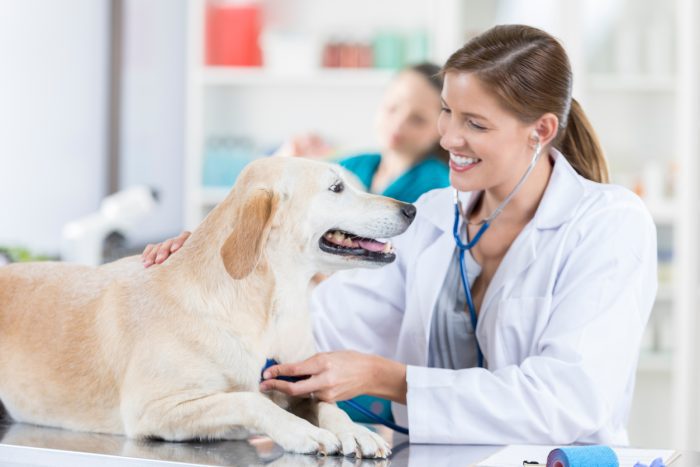Animals & Children: How to Build a Pawsitive Relationship
The loving and unforgettable bond a child can have with an animal can be monumental to their identity, development, empathy, and self-esteem. Every parent wants their children and pets to live in harmony with each other, but the unpredictability of both young children and animals can lead to unfortunate ‒ and sometimes traumatic ‒ events.

At Walhalla Veterinary Hospital, we want the best for our pet patients and their human families. In this article, we’ll explore building a pawsitive relationship between animals and children to ensure the safety and well-being of all in your household.
If you’d like to speak to a veterinarian directly and are located in West Union, SC, or Oconee County, we encourage you to get in touch with us today. Otherwise, let’s get started!
Supervise Young Children & Animals
Young children do not yet grasp the ability to control their emotions and are prone to impulsive behaviors that can be scary, stressful, or directly inflicted upon animals.
We recommend parents are actively present and provide their undivided attention when a child who is six years old or younger interacts with a pet.
Active supervision is also highly recommended if your infant, toddler, or young child spends time around unfamiliar animals, such as a neighbor or babysitter’s dog, for example. Knowing a dog’s history around children can be beneficial but not indicative of future interactions. So, it’s better to approach all interactions between animals and young children with a level of caution.
As your child gets older and develops a relationship with the family pet, you can become more passive in your level of supervision. However, it’s important to know how to facilitate positive interactions and build trust before you allow children and animals to spend exclusive time with one another.
Minimize Harmful Behaviors Towards Animals
Positive interactions build positive relationships. It seems simple, but like humans, animals are emotional and are prone to experiencing and responding to fear, stress, and anger.
For dogs and cats, interactions with children mustn’t be scary or stressful ‒ they should be comforting and compassionate. However, the unpredictability of children’s behavior can often scare or harm pets unintentionally and subsequently lead to behaviors like growling, hissing, snapping, scratching, or biting.
With that said, you can explain to your child that the following behaviors can scare animals and cause them to react aggressively:
- Hitting
- Kicking
- Grabbing
- Poking
- Teasing
- Pulling tails
- Sitting on or trying to ride animals
These behaviors can even be scary to kids, so it may be helpful to explain them in these relatable terms.
When cats or dogs are eating or playing, children also shouldn’t grab or try to take away their food or toys. Even hugging can induce stress in some dogs and cats, so until your pet and child have developed a closer relationship, or you understand your pet’s triggers, err on the side of caution when it comes to hugging.
Know When Your Dog or Cat Is Scared/Stressed
By understanding your pet’s body language, you can quickly identify when your pet may potentially react to fear or stress and cause harm to a child. Here are the tell-tale signs that your dog or cat may be stressed, uncomfortable, or afraid:
- Excessive grooming, barking or whining
- Side-eyeing or dilated pupils
- Yawning
- Hiding
- Pacing
- Shaking
Dogs and cats that are stressed may also tuck in their tails or flatten their ears. If your pet exhibits any of these signs, it’s best to avoid yelling, gently separate your child, and give your dog or cat space.
The state of your pet’s long-term mental health can also affect their relationships with children and the rest of your family. By understanding pet mental health, you can better identify signs of stress, irritability, and discomfort in your dog or cat and prevent aggressive behavior.
Redirect Behavior & Encourage Bonding Time
The more interaction between your child and pet, the more opportunity there is for their relationship to grow. With your supervision, have your child take part in your pet’s day-to-day care, like feeding them, filling their water bowls, brushing them, or taking them for a walk.
When your child behaves in a way that may frighten or harm an animal, you can redirect them to do something more positive.
For example, if your child pulls your dog or cat’s tail, explain to them, “We don’t pull their tail. Let’s pet them softly instead.”
On the flip side, when your child is gentle and kind towards their dog or cat, praise them. Similarly, you should praise your pet when they interact gently with children, up close and at a distance.
Let’s Build a Pawsitive Relationship with Your Pets & Children
As a leading animal clinic that has served West Union, SC, since 1968, Walhalla Veterinary Hospital has witnessed the incredible bond that children and pets can share ‒ and we’ve seen what these relationships can do not only for children but for the health and well-being of animals, too.
As a parent, you want the best for your children. By nurturing a harmonious relationship between your pets and children, you can teach your child how to have a lifelong love and appreciation for all animals.
One of the first steps you can take to foster pawsitive animal-children relationships is making sure your pet is healthy. If you’re located in West Union, SC or Oconee County, contact us today to schedule an appointment with a veterinarian!




